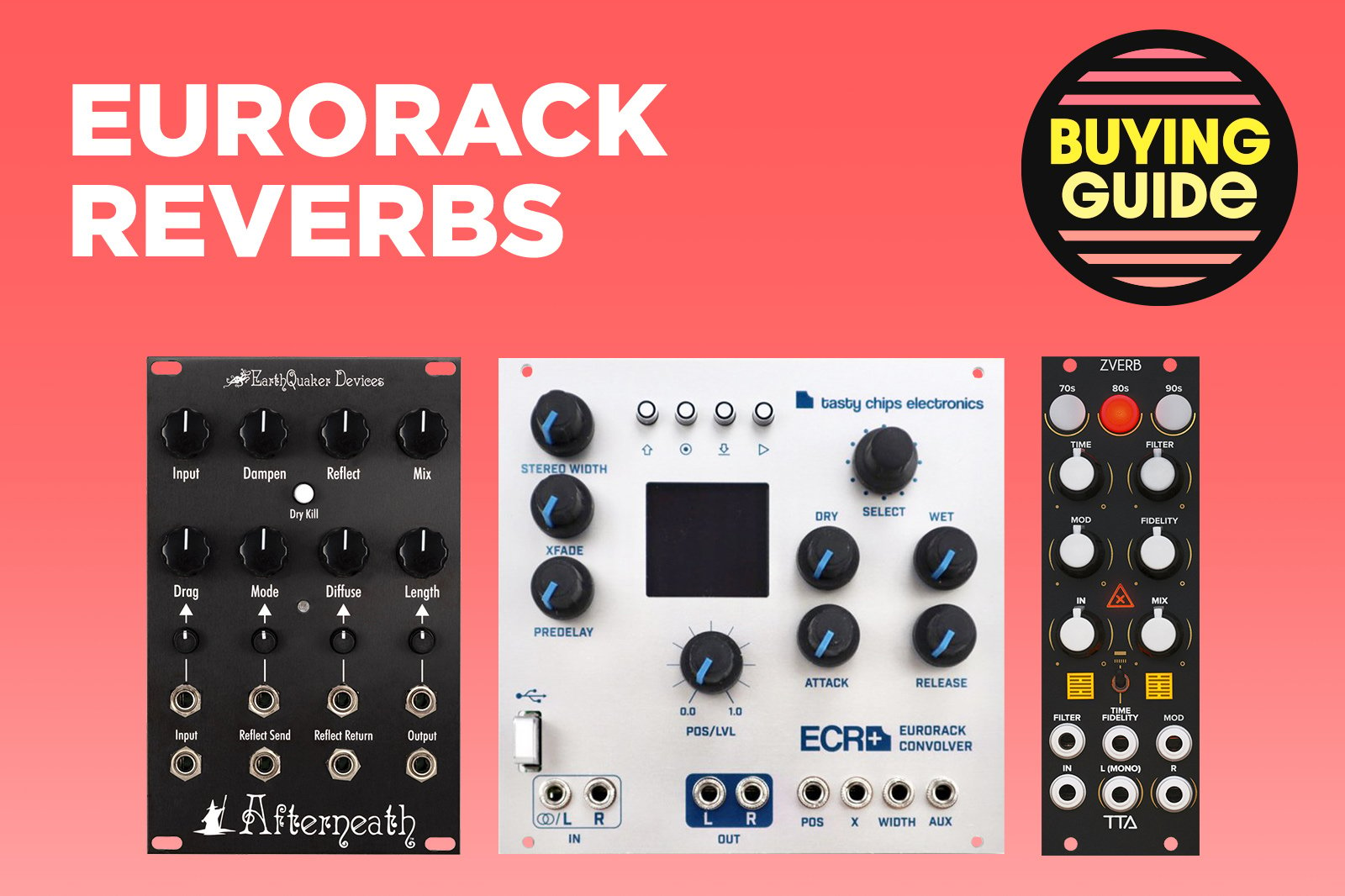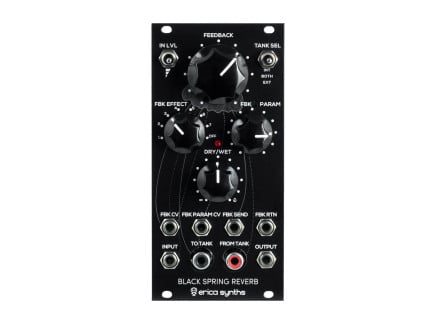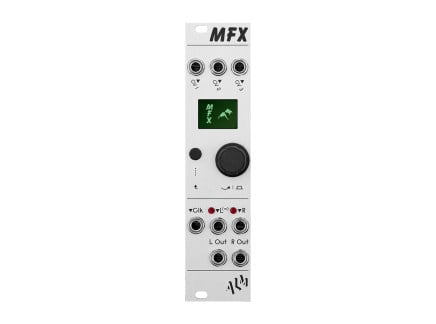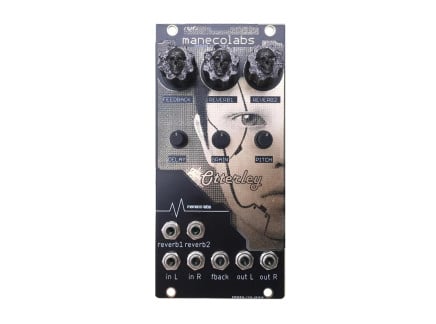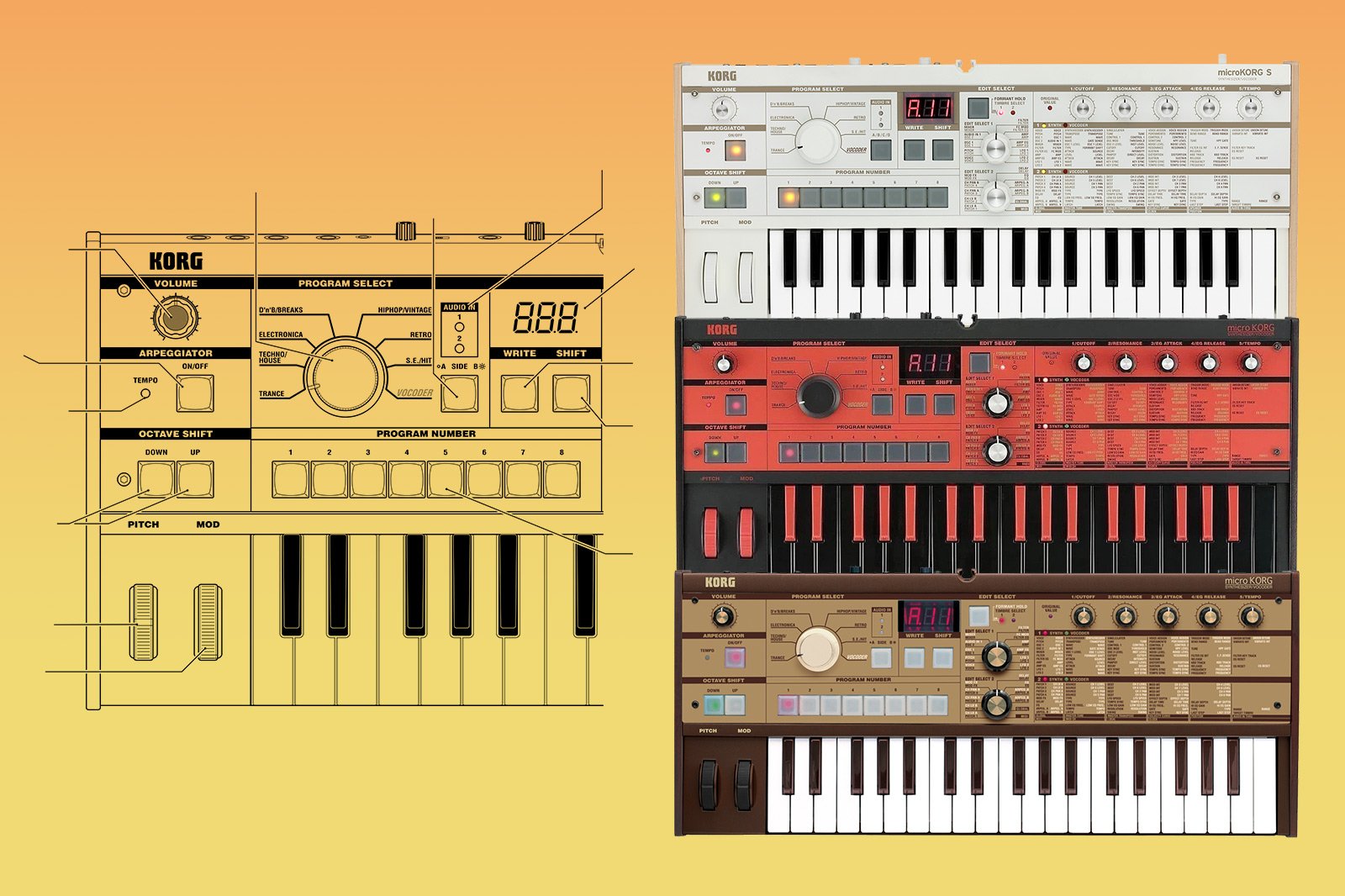The primary use of reverb might be to put your listener in a specific space. But in the world of Eurorack modular synthesis, reverb can be a powerful sound design tool for performances and compositions. With CV signals modulating reverb parameters, it is possible to find unrealistic spaces that transport your listeners to imaginary worlds.
Of course, there are modules that let you emulate classic room and plate reverbs, too. In this buying guide, we have shortlisted 9 of the best Eurorack reverb modules out there. There is something for everyone here. If your skiff is crying for a reverb module, jump in and pick from the best of the lot.
Qu-Bit Electronix Aurora: Stereo Spectral Reverb
Imagine a reverb that sounds different every time you plug in a different input signal. That’s Qu-Bit’s Aurora for you, a spectral reverb that’s dependent on the incoming signal. The reverb module separates the pitch and time parameters of the audio input. You can play around with them separately, which leads you to a wide array of sonic territories. From icy shimmers to pitch-shifted time-stretching, glassy swirls, and whale songs, Aurora can do a lot.
The module has a phase vocoder audio engine that uses a Fast Fourier Transform for processing the incoming audio. Changing the FFT size changes the relationship between how frequency and time parameters are processed. With large FFT sizes, you get a more accurate frequency response. Smaller values are more suitable for transient-rich information, such as your drums.
There is plenty of control to shape the tone of your reverb. Dial in warp for pitch-shifting effects. Control the tail of your reverbs with the Decay parameters. Stretch the frequency content of incoming audio with Blur for those washed-out echoes and ambiences. There is a built-in filter that you can control manually or with CV to get different tonalities out of it. Aurora can even do rhythmic delays. Keep Blur down and play around with Reflect for transitioning between different delay times for rhythmic results. Dial in a healthy amount of Blur for those long tails, even with very short sound sources.
You can also experiment with different algorithms by changing Aurora’s firmware via USB. For example, if you would like a more conventional reverb for your system, there is the Feedback Delay Network firmware.
Key features:
- Spectral reverb with phase vocoder audio engine that works on FFT synthesis
- Separates incoming audio’s time and frequency properties
- LED strip for visual feedback
- Warp control for pitch shifting across three octaves and trackable with a 1V/oct input
- Blur control for adding time-stretching artifacts
- Built-in filter for shaping the tone of your reverb
- USB for firmware switching
- Great for: Glassy shimmers, whale songs, and otherworldly sonic territories
Strymon Starlab: Time-Warped Reverberator
Much like the Magneto for delays, Strymon Starlab gives you immense control over your reverbs. From conventional room ambiences to more experimental sound design territory, this feature-packed reverb module can do a lot. The module’s interface is neatly divided into five key sections. Combined with the big knobs, this module is very playable in live settings.
You can choose between three different reverb types. There is Sparse for granular sounding reverb, plate-like reverb with Dense, and Diffuse for those washed-out textures. You can easily dial in the size of your reverb space, which correlates to the pitch of the reverb. The pitch can be quantized to one of the 15 available scales. The interface for selecting the scales on the fly can be a bit tricky to use precisely, though.
But, you can save up to four presets and cycle through them with CV. For shaping the tone of your reverb, there are two primary controls—Harmonics and a filter. Harmonics has two controls: Shimmer for adding a pitched tail to your reverb, and Glimmer for saturating your output. The two can be dialed in independently, and together, they can give you a wide array of textures.
A built-in LFO can be routed to pitch, filter, or delay for more movement. You can control the speed, depth, and even the waveshape of your LFO. The Starlab can even do rhythmic reverbs that can be great for live performances. Supplying a gate input to the Clear function clears the audio buffer. Supplying a gate CV to the input mutes the incoming audio. Apply different gate rhythms to the two inputs for interesting rhythmic results.
Key features:
- Playable user interface with big control knobs
- 1V/oct tracking across 15 selectable scales
- Dedicated Karplus-Strong synthesis section: yep, you can use it as a synth voice all its own
- 3 reverb algorithms
- Input gain to add drive to your signal
- Controls for Size, Decay, Dry/Wet, and Feedback
- Built-in filter
- Built-in LFO that can be routed to delay, pitch, or filter
- Harmonics for adding pitch and saturation to your reverb tail
- Infinite for freezing the input signal
- Save upto 4 presets, selectable via CV
- Great for: Room reverbs, shimmers, saturated reverbs, and extensive control over your reverb tone
Noise Engineering Desmodus Versio: Stereo DSP Reverb
The Desmodus Versio by Noise Engineering is less of a room ambience reverb and more of a sound design tool. Instead of emulating natural spaces such as rooms and halls, it generates synthetic reverb tails that you can shape for different sonic results. The reverb works with delay lines. Dense controls the spacing between the delay lines. Turn it to the left for more delay-like tones. On the right, you get more sustained ambiences. Regen controls the feedback amount. Turn it up substantially and you start to get interesting sidechaining effects.
You can select between three different reverb styles with a handy switch, including Shimmer for those pitch-shifted reverb tails. You can also change how the delay lines respond when you play around with the various parameters. You can go from smooth fades to abrupt jumps and pitch-shifting, all with a flick of a switch.
There is an internal LFO that modulates the delay lines. You have control over LFO depth and speed to shape the final output. Much like Qu-Bit Aurora, you can change the firmware on the Desmodus Versio with USB—so, you can access any Noise Engineering Versio module's features by swapping the firmware. These firmwares range from stereo distortion to multi-tap delays, auto-wah effects, and more…and speaking of firmwares, there is the Electus Versio firmware, another flavor of reverb.
Electus Versio adds external clock sync capability to the module, which means you can get clocked reverbs. Imagine if you could dial in your reverb only on certain hits of your snares and percussions. With the Electus Versio firmware, it is possible. The firmware also uses longer delay times compared to the Desmodus firmware.
Key features:
- Synthetic tail generator for sound design possibilities
- Stereo in and stereo out
- Firmware update with USB
- 3 reverb styles to choose from
- Choose how delay lines respond to parameter changes
- Firmware can change module to act as different types of effects
- Electus Versio firmware for clock-synced reverbs
- Great for: Sound design, shimmers, and clock-synced reverbs
Erica Synths Black Spring Reverb: a Feedback Dream
A reinterpretation of a classic reverb, Erica Synths Black Spring Reverb comes with a spring reverb tank that you can install in your modular rack. You can even attach other external spring reverb tanks to the unit and create unique spaces and textures. The module uses a vactrol audio compressor that gives it a distinct sound.
But the feedback effects are where the magic happens. You can choose between seven different effects that are applied to the feedback circuit. From Ringmod to control the frequency of the feedback to pitch-shifters and delay for feedback, there is a lot to experiment with.
The available parameters to tweak might not be as extensive as Strymon Starlab; or even as experimental as Make Noise Erbe-Verb. But Black Spring Reverb can still surprise you. It really shines when the (limited) parameters are modulated with CV signals. As you start to play around with the various feedback effects parameters with CV, you start to unlock surprising sonic territories.
You can also include effects from elsewhere in your rack with the send/return jacks.
Key features:
- Comes with a compact spring reverb tank that is skiff-friendly
- Add an external reverb tank for experimentation
- Use either the internal tank, the external tank, or a combination of both for reverbs
- Select between 7 different feedback effects
- Override internal feedback effects by patching in external effects
- Great for: Modern spring reverbs and experimental spaces
Earthquaker Afterneath: a Beloved Classic in Eurorack Format
A recreation of the popular reverb pedal, the Earthquaker Devices Afterneath module has some added features for the Eurorack world. There is send and return for the feedback path. It opens up possibilities to include external effects for shaping your reverb tone.
Like Noise Engineering Desmodus Versio, Afterneath works with delay lines. Drag controls the spacing between the delay lines. To the left, you get a more delay-like effect. To the right, you start to get more sustained tails. As you modulate Drag, either manually or with CV, you will get a change in pitch of your reverb tails. The pitch change and how the pitch change occurs is determined by the mode you are in. You can select between nine different modes, ranging from unquantized to pentatonic scales and octave jumps. On the downside, visual feedback for Mode information is not very intuitive.
Quantized pitch-changes come in handy when you want to use Afterneath as a pure tone generator. Turn the feedback high enough with Reflect and the module starts to self-oscillate. There is also a handy Dry Kill switch, which eliminates dry signal from the output. It could be useful for creating washed-out transitions in live settings.
The simple, cleanly-laid interface makes it a lot of fun to play with in live performances.
Key features:
- Mono input and output
- Send and return for the feedback circuit
- Switch to cut off the dry signal
- Self-oscillation at high feedback values
- 9 different modes to control the pitch quantization of your reverb tails
- CV inputs with dedicated attenuators for 4 parameters
- Great for: Pitched reverbs and shimmers
Tiptop ZVERB: Multi-Mode Reverb
The Tiptop ZVERB is a straightforward reverb module that lets you choose between 24 different reverb algorithms. They are distributed in three banks, separated by eras—70s, 80s, and 90s
Each bank has classic reverb types that have the sound of that era. So, you get easy access to your plates, halls, and rooms. But there are a few surprises thrown in, as well. For example, the ‘70s bank has a Tape>Plate algorithm, which is a tape delay going into a plate reverb. Similarly, there are pitch-shifting algorithms in the ‘90s and shimmer algorithms in the ‘80s banks, respectively.
Selecting between the different banks and algorithms is easy with the three buttons at the top. What gives Z-Verb its character is the Fidelity control. The DSP chip of the module is clocked with an analog VCO. Turning down the fidelity slows down this clock and leads to lo-fi artifacts. Turn fidelity a good amount to the left and you start to enter distortion territory.
There are CV inputs for the built-in filter and feedback. The third CV input can either be routed to Time or Fidelity. The limited choices in shaping your reverb make the Z-Verb a great workhorse reverb for Eurorack.
Key features:
- 24 reverb algorithms distributed in 3 banks
- Easy access to ‘70s, ‘80s, and ‘90s reverbs
- Mono input and stereo output
- Fidelity control for lo-fi or hi-fi sound
- CV inputs for filter, feedback, and time or fidelity
- Great for: Vintage reverbs, gated reverbs, and classic reverb styles such as rooms and plates
2hp Verb: Straight to the Point
If you are short on space in your rack and you still want a reliable reverb, the 2hp Verb is your answer. The nifty module has a stereo input and a stereo output. There is Damp control for shaping the tone of your reverb. And there is a Time knob for controlling the decay of your reverb tails. You can dial-in a healthy amount of decay for long sustains even with short sound.
CV control for the mix knob lets you build more dynamic patches.
Key features:
- Stereo input and output
- Manual control for decay time
- Manual control for Damp to shape the reverb tone
- CV control for the mix knob
- Great for: Lush reverbs
Our Takeaway
Before you pick a reverb module from this list, figure out what your primary functionality is going to be for reverbs. If you are only looking to add ambiences and use reverb as an end-of-mix element, pick something straightforward. Tiptop Z-Verb or 2hp Verb could be good options for that purpose.
But if you are looking to get more creative with reverb and use it as a sound design tool, Qu-Bit Aurora, Make Noise Erbe-Verb, Noise Engineering Desmodus Versio, and Earthquaker's Afterneath are better bets. And if you are someone who prefers great control over how their reverbs sound, Strymon Starlab could be your preferred pick.
The tone is an obvious factor when picking a reverb. But versatility, experimentation, and the interface are equally relevant factors to take into account when picking a reverb module for your skiff.

